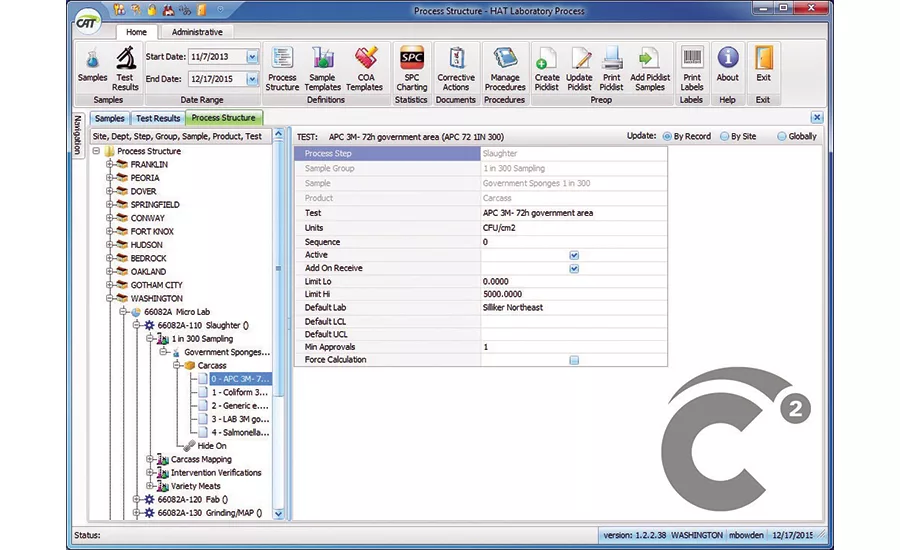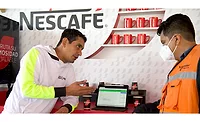Engineering R&D
Making LIMS relevant to food processing today
LIMS (laboratory information management systems) software is often a generalized, "one-size-fits-all" approach, not fine-tuned for the food and beverage industry.


CAT Squared specializes in developing manufacturing software for the food industry. Source: CAT Squared.
Your company makes food and beverage products. So, why would you use information systems designed for metals, plastics or chemical products? They were developed for other industries and don’t address your specialized needs for quality control and food safety management. Plus, trying to adapt a general-coverage LIMS software application to fit your needs can be a real challenge and may be costly as well.
CAT Squared, a supplier of business intelligence, shop floor, quality and monitoring, warehousing and distribution software specifically for the food and beverage industry, has been fine-tuning its LIMS application to make it not only relevant to food and beverage, but also compatible with evolving quality and regulatory demands.
FE interviewed Mark Bowden, CAT Squared research and development manager, to get a handle on this ongoing process.
FE: LIMS is usually a generic application. What functions/capabilities does a typical LIMS provide?
Mark Bowden: As you may know, there are many fully generic lab products out there. While these products may be capable of testing the density of metal, that has little relevance to the food industry. By working with development partners in the food industry to determine the specifications for our LIMS product, we have been able to incorporate many processes that are specific to the industry, from preoperational testing and sample collection to the recording of test results, performing test approvals and auditing.
FE: What functions/capabilities should a food-/ beverage-specific LIMS application provide?
Bowden: Because the LIMS product development has been done with input from our partners in the food processing industry, many food-specific lab considerations have been included. For example, we can natively interface with equipment like the 3M plate reader and FoodScan analyzers that are widely used within the food processing industry.
FE: You’ve been working with Cargill to fine-tune LIMS even more. What are some of the results of these efforts?
Bowden: The value of developing our LIMS product with the help of major food processors like Cargill cannot be overstated. Our development partners provide us with information that allows us to focus more intensely on the specific needs of the food processing industry. From developing a process structure for sample collection that mirrors real-world manufacturing activities to creating testing-and-results collection steps to optimize lab performance, our development partners provide us with invaluable input to create feature-rich solutions for their laboratories.
FE: LIMS sometimes interfaces directly with internal lab instrumentation, but often doesn’t connect to many external systems. What changes are you seeing in this respect?
Bowden: Actually, LIMS has the ability to share information with other information systems as needed. In addition to our LIMS application, which is used for processing samples and recording test results in the lab, we can utilize our Interface Manager service along with custom interfaces to communicate with virtually any other information system. We routinely use a number of technologies, including direct database communications, XML, EDI, flat files and web services, to interface with these systems.
FE: Many food and beverage processors contract out lab services. How does your application accommodate input from these labs?
Bowden: Using our LIMS application, samples can be collected and barcoded, and a chain of custody can be generated for samples sent out to third-party labs along with XML documents containing relevant information about the samples. The labs complete their testing and record the results in the XML document, which can then be automatically imported back into LIMS.
FE: How should a modern LIMS connect with a food safety management system (FSMS)?
Bowden: We have customers that use the LIMS software to tie into their shipping systems, with lab personnel placing a product lot on hold if the test results warrant it. This process prevents a bill of lading for suspect product from ever being generated and that product from being distributed.
FE: How should a modern LIMS interface with a quality management system (QMS)?
Bowden: Interestingly, the LIMS software is really a sister application to one of our flagship products called HAT [Hazard Analysis Tools] in that they share a common structure. While LIMS is designed for the lab testing of samples, HAT software serves both food safety and quality management purposes on the plant floor. There are almost endless uses for HAT software as a production-management tool, ranging from identifying food safety hazards to improving overall production yields. We are currently scheduled to launch a new application called FSQM [Food Safety Quality Management] in 2016 that incorporates our best HAT features and adds many more.
FE: Measurements previously made in a lab can now be done in/on line. How does a LIMS accommodate automated external inputs?
Bowden: Our systems include technologies utilizing wireless handheld devices that access TCP-IP connections, wireless Bluetooth connectivity, tablet applications, touchscreen desktop applications and others. When provided with the appropriate communication protocols, we can even connect to equipment and instruments and access their data directly.
FE: How does a LIMS accommodate supplier specifications for ingredients?
Bowden: LIMS can be used for testing anything a lab can accommodate and includes the capability for users to create their own user-definable sample attributes, which we call sample descriptors. With these sample descriptors, users can collect virtually any type of information they want and tailor the LIMS product for their specific needs.
FE: What is the future of LIMS in food and beverage?
Bowden: As an industry, we are always moving closer to a completely paperless environment. One recent enhancement to our LIMS application is a module, called the Data Communications Manager, that is used to create user-definable electronic forms, which can be used to replace paper-based government forms and versioned as the form requirements change. Additionally, the electronic forms can be broken into groups, with one set of people completing a section of a document and having the system automatically notify another set of people that the document needs their attention.
For more information, visit catsquared.com.
Looking for a reprint of this article?
From high-res PDFs to custom plaques, order your copy today!









